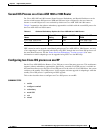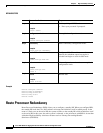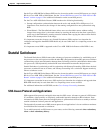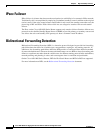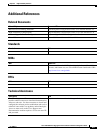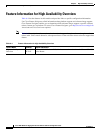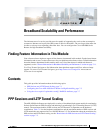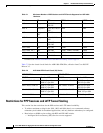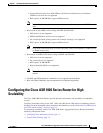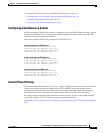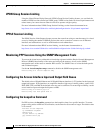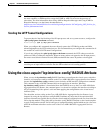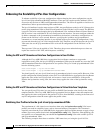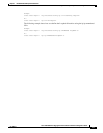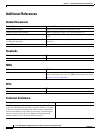
7-3
Cisco ASR 1000 Series Aggregation Services Routers Software Configuration Guide
OL-16506-17
Chapter 7 Broadband Scalability and Performance
Configuring the Cisco ASR 1000 Series Router for High Scalability
–
Point-to-Point Protocol over ATM (PPPoA) and Point-to-Point Protocol over Ethernet
(PPPoEoA) sessions are not supported
–
RP2 requires 16 GB DRAM to support 48000 sessions
Note If any of the listed restrictions is not met, the router scales to a maximum of 32000 sessions
only.
• Restrictions on the 64000 session scaling with RP2 and ESP-40G:
–
ISG services are not supported
–
PPPoA and PPPoEoA sessions are not supported
–
Per-session QoS with queuing actions (for example, shaping) is not supported
–
RP2 requires 16 GB DRAM to support 64000 sessions
Note If any of the listed restrictions is not met, the router scales to a maximum of 32000 sessions
or 48000 sessions only.
• Restrictions on 64000 L2TP tunnel scaling with RP2 and ESP-40G:
–
ISG services are not supported
–
Per-session QoS is not supported
–
RP2 requires 16 GB DRAM
–
High Availability (SSO) is not supported
Note If any of the listed restrictions is not met, the router scales to a maximum of 16000 L2TP
tunnels.
• The RP2 and ESP10 hardware combination is not supported for broadband.
• RP1 with 2GB of DRAM is not recommended for broadband deployment.
Configuring the Cisco ASR 1000 Series Router for High
Scalability
The Cisco ASR 1000 Series Routers provide powerful performance and scalability for embedded
services.
To achieve maximum scaling on the 1001, 1002, and 1004 chassis, IOS software redundancy must be
disabled. For more information about restrictions and limitations, see the “Restrictions for PPP Sessions
and L2TP Tunnel Scaling” section on page 7-2.
To ensure high scalability on the Cisco ASR 1000 Series Aggregation Services Router, perform the
following configuration tasks:
• Configuring Call Admission Control, page 7-5
• Control Plane Policing, page 7-5



